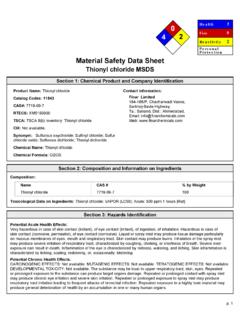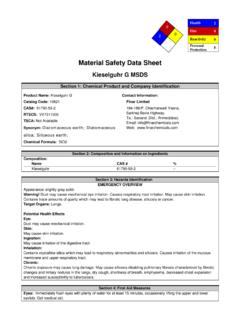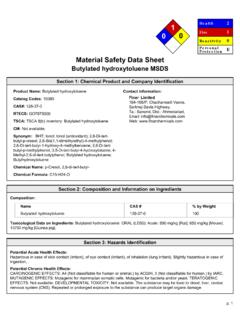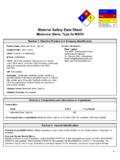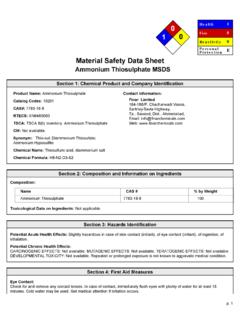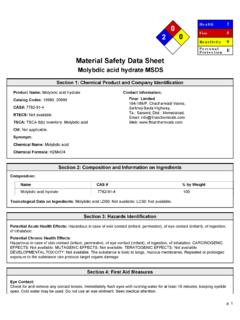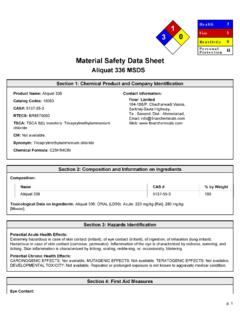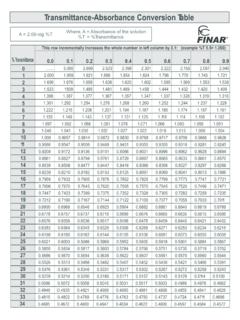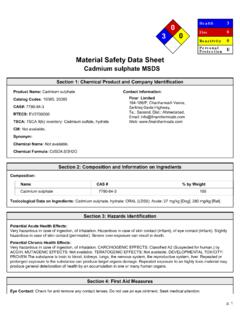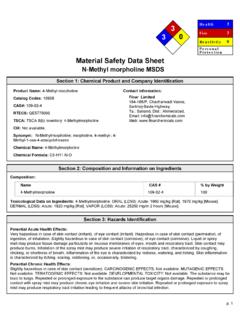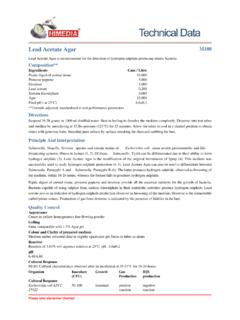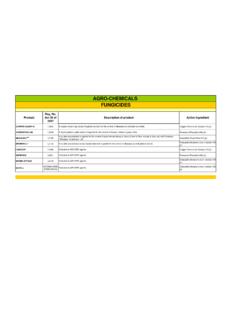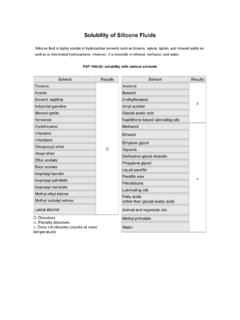Transcription of Material Safety Data Sheet - finarchemicals.com
1 P. 1 1 2 0He a lt hFireRe a c t iv it yP e rs o n a lP ro t e c t io n210 EMaterial Safety data SheetPotassium acetate MSDSS ection 1: Chemical Product and Company IdentificationProduct Name: Potassium acetateCatalog Codes: 11205, 21205 CAS#: 127-08-2 RTECS: AJ3325000 TSCA: TSCA 8(b) inventory: Potassium acetateCI#: Not : Chemical Name: Not Formula: CH3 COOKC ontact Information:Finar Limited184-186/P, Chacharwadi Vasna, Sarkhej-Bavla Highway, Ta.: Sanand, Dist.: Ahmedabad, Email: Web: 2: Composition and Information on IngredientsComposition:NameCAS #% by WeightPotassium acetate127-08-2100 Toxicological data on Ingredients: Potassium acetate : ORAL (LD50): Acute: 3250 mg/kg [Rat].
2 Section 3: Hazards IdentificationPotential Acute Health Effects:Hazardous in case of eye contact (irritant), of ingestion. Slightly hazardous in case of skin contact (irritant), of Chronic Health Effects:CARCINOGENIC EFFECTS: Not available. MUTAGENIC EFFECTS: Not available. TERATOGENIC EFFECTS: Not TOXICITY: Not available. Repeated or prolonged exposure is not known to aggravate medical 4: First Aid MeasuresEye Contact:Check for and remove any contact lenses. Immediately flush eyes with running water for at least 15 minutes, keeping eyelidsopen. Cold water may be used. Do not use an eye ointment.
3 Seek medical Contact:p. 2 After contact with skin, wash immediately with plenty of water. Gently and thoroughly wash the contaminated skin with runningwater and non-abrasive soap. Be particularly careful to clean folds, crevices, creases and groin. Cold water may be the irritated skin with an emollient. If irritation persists, seek medical attention. Wash contaminated clothing Skin Contact: Not : Allow the victim to rest in a well ventilated area. Seek immediate medical Inhalation: Not :Do not induce vomiting. Loosen tight clothing such as a collar, tie, belt or waistband. If the victim is not breathing, performmouth-to-mouth resuscitation.
4 Seek immediate medical Ingestion: Not 5: Fire and Explosion DataFlammability of the Product: May be combustible at high Temperature: Not Points: Not Limits: Not of Combustion: These products are carbon oxides (CO, CO2).Fire Hazards in Presence of Various Substances: Not Hazards in Presence of Various Substances:Risks of explosion of the product in presence of mechanical impact: Not available. Risks of explosion of the product inpresence of static discharge: Not Fighting Media and Instructions:SMALL FIRE: Use DRY chemical powder. LARGE FIRE: Use water spray, fog or foam.
5 Do not use water Remarks on Fire Hazards: Not Remarks on Explosion Hazards: Not 6: Accidental Release MeasuresSmall Spill:Use appropriate tools to put the spilled solid in a convenient waste disposal container. If necessary: Neutralize the residue witha dilute solution of acetic acid. Finish cleaning by spreading water on the contaminated surface and dispose of according tolocal and regional authority Spill:Use a shovel to put the Material into a convenient waste disposal container. Neutralize the residue with a dilute solutionof acetic acid. Finish cleaning by spreading water on the contaminated surface and allow to evacuate through the 7: Handling and StoragePrecautions:Keep away from heat.
6 Keep away from sources of ignition. Empty containers pose a fire risk, evaporate the residue undera fume hood. Ground all equipment containing Material . Do not ingest. Do not breathe dust. Avoid contact with eyes Wearsuitable protective clothing If ingested, seek medical advice immediately and show the container or the 3 Storage:Keep container dry. Keep in a cool place. Ground all equipment containing Material . Keep container tightly closed. Keep in acool, well-ventilated place. Combustible materials should be stored away from extreme heat and away from strong 8: Exposure Controls/Personal ProtectionEngineering Controls:Use process enclosures, local exhaust ventilation, or other engineering controls to keep airborne levels below recommendedexposure limits.
7 If user operations generate dust, fume or mist, use ventilation to keep exposure to airborne contaminantsbelow the exposure Protection:Splash goggles. Lab coat. Dust respirator. Be sure to use an approved/certified respirator or equivalent. Protection in Case of a Large Spill:Splash goggles. Full suit. Dust respirator. Boots. Gloves. A self contained breathing apparatus should be used to avoidinhalation of the product. Suggested protective clothing might not be sufficient; consult a specialist BEFORE handling Limits: Not 9: Physical and Chemical PropertiesPhysical state and appearance: : Not : Not Weight: g/moleColor: Not (1% soln/water): 10 [Basic.]
8 ]Boiling Point: Point: 292 C ( F)Critical Temperature: Not Gravity: (Water = 1)Vapor Pressure: Not Density: Not : Not Threshold: Not Dist. Coeff.: Not (in Water): Not Properties: See solubility in : Easily soluble in cold 10: Stability and Reactivity DataStability: The product is 4 Instability Temperature: Not of Instability: Not with various substances: Not : Non-corrosive in presence of Remarks on Reactivity: Not Remarks on Corrosivity: Not : 11: Toxicological InformationRoutes of Entry: Eye contact. to Animals: Acute oral toxicity (LD50): 3250 mg/kg [Rat].
9 Chronic Effects on Humans: Not Toxic Effects on Humans:Hazardous in case of ingestion. Slightly hazardous in case of skin contact (irritant), of Remarks on Toxicity to Animals: Not Remarks on Chronic Effects on Humans: Not Remarks on other Toxic Effects on Humans: Not 12: Ecological InformationEcotoxicity: Not and COD: Not of Biodegradation:Possibly hazardous short term degradation products are not likely. However, long term degradation products may of the Products of Biodegradation: The products of degradation are more Remarks on the Products of Biodegradation: Not 13: Disposal ConsiderationsWaste Disposal:Section 14: Transport InformationDOT Classification: Not a DOT controlled Material (United States).
10 Identification: Not Provisions for Transport: Not 15: Other Regulatory InformationFederal and State Regulations: TSCA 8(b) inventory: Potassium acetatep. 5 Other Regulations: Not Classifications:WHMIS (Canada): Not controlled under WHMIS (Canada).DSCL (EEC): R36- Irritating to ( ):Health Hazard: 2 Fire Hazard: 1 Reactivity: 0 Personal Protection: ENational Fire Protection Association ( ):Health: 2 Flammability: 1 Reactivity: 0 Specific hazard:Protective Equipment:Gloves. Lab coat. Dust respirator. Be sure to use an approved/certified respirator or equivalent. Splash 16: Other InformationReferences: Not Special Considerations: Not : 10/06/2010 Last Updated: 28/11/2012 The information above is believed to be accurate and represents the best information currently available to us.
